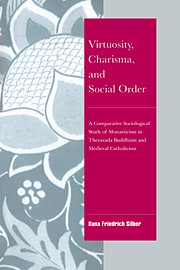 Virtuosity, Charisma and Social Order
Virtuosity, Charisma and Social Order Book contents
- Frontmatter
- Contents
- Preface
- Introduction
- Part I Virtuosi and society: elements of a comparative macrosociological approach
- Part II Virtuosi and society in Theravada Buddhism
- Part III Virtuosi and society in medieval Catholicism
- 6 Ideological groundings: plurality and conditional exchange
- 7 Virtuosity institutionalized: monasticism in social context
- 8 Virtuoso radicalism: a self-defeating triumph
- Part IV Virtuosity, charisma, and social order
- Conclusion: Religious virtuosity as ideological power: some implications for the comparative study of civilizations
- Bibliography
- Index
8 - Virtuoso radicalism: a self-defeating triumph
Published online by Cambridge University Press: 09 October 2009
- Frontmatter
- Contents
- Preface
- Introduction
- Part I Virtuosi and society: elements of a comparative macrosociological approach
- Part II Virtuosi and society in Theravada Buddhism
- Part III Virtuosi and society in medieval Catholicism
- 6 Ideological groundings: plurality and conditional exchange
- 7 Virtuosity institutionalized: monasticism in social context
- 8 Virtuoso radicalism: a self-defeating triumph
- Part IV Virtuosity, charisma, and social order
- Conclusion: Religious virtuosity as ideological power: some implications for the comparative study of civilizations
- Bibliography
- Index
Summary
It is clear from the previous chapter that Christian monasticism was a more “dynamic” and autonomous institution than the Theravada Sangha, forcefully interacting with other social sectors and playing an important part in an arena of shifting social forces and coalitions. Up to the eleventh century, this part was mostly conservative. Abbots usually bowed to and even supported the external authority of kings and popes, while fending for their own material and ideal interests in a world they basically accepted as it was. The strong influence of monasticism in the Gregorian attempt to restructure Christian society was a sign of monasticism's vitality and prestige. Ultimately, however, this influence should be understood as the result of a close collaboration with the ecclesiastical hierarchy – an effective alloy of monastic prestige and ecclesiastical institutional power. On the whole, therefore, Christian monasticism cannot be said to have been much more anti- or counterstructural than its Theravada equivalent, despite its criticism of the world – and of the Church in the world especially – so important at its emergence, and maintained in a more subdued fashion throughout its subsequent stages. Seguy's conception of Christian monasticism as a form of “implicit protest” (see this volume, Chapter 2) may be applied without much reservation throughout the period under study, although this aspect may seem at times to be completely superseded by the elaborate network of mutual support and exchange between monasteries and society.
- Type
- Chapter
- Information
- Virtuosity, Charisma and Social OrderA Comparative Sociological Study of Monasticism in Theravada Buddhism and Medieval Catholicism, pp. 173 - 184Publisher: Cambridge University PressPrint publication year: 1995
